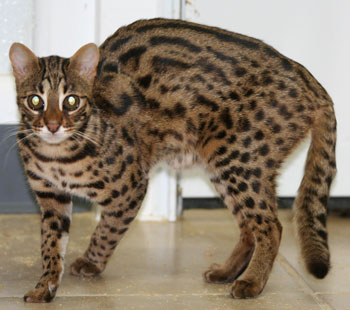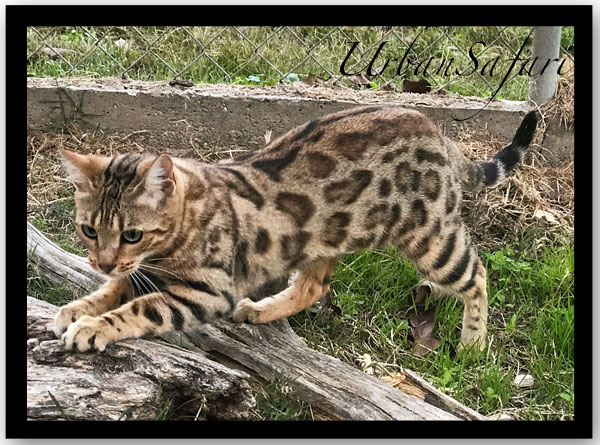Bengal Cat Breed Information
The Bengal Cat's History

In 1963 Jean Mill bought a female Asian Leopard Cat and because the animal seemed lonely, a domestic tomcat was added to keep her company. An unexpected little female hybrid, named "Kin-Kin," was born. This cat, in turn, produced a second generation litter.Beginning from 1975, Jean resumed her breeding programs after acquiring eight female ALC hybrids from the late Dr. Willard Centerwall, a physician and geneticist who was involved in research isolating the genes that are responsible for the ALC's immunity to feline leukemia (FeL). In 1980, while in India, Mrs. Mill brought back to California a male domestic cat . This animal's overall coloring and markings came close to the "look" of the ALC, but also had a coat that was very glittered. As this cat matured, it was bred to the Centerwall female hybrids, the offspring of which, became the genetic foundation for the present-day Bengal Cat. Doctors Greg and Elizabeth Kent were also breeding ALC hybrids during this time . Jean took an interest in their hybrid programs, and bred two of her females to their Asian Leopard Cat, Baghara Khan. Although Jean Mill is credited with laying the foundation for the Bengal Cat, others also contributed.
The Bengal Cat's Ancestor, the Asian Leopard Cat

The Asian Leopard Cat is a small forest cat found in Asia, India, China, and Korea. Exact size and weight varies among the 10 subspecies but averages between 7 to 15 lbs. and 25 to 32 inches in length. All subspecies have a spotted or ringed tail, with a black tail tip, four black bands running from the forehead to the back of the neck, breaking up into elongated spots on the neck and shoulders, often forming a " broken necklace". The round black ears have ocelli, 'night eyes' on the back, and all cats have a white underside, throat and cheek-flashes. The underparts are spotted on the white background. The body markings can be solid or rosetted.
The Bengal Cat's Appearance

The Bengal cat is a medium to large cat with a long, muscular body. Females are generally in the 7 to 10 pound range and males fall between 12 - 16 pounds. There has been the odd male that reaches 18 - 20 pounds but this is rare. They are large-boned, well-muscled cats with the male in particular being extremely muscular. Non-altered males often continue to put on muscle mass up to two years of age. The head is broad modified wedge with small round ears & pronounced whisker pads. Eyes are rimmed with black mascara markings. The tail is thick with a black tip. The coat is thick, beautifully sleek & soft and feels more like a pelt than fur. The belly is whited & should also have spots. There are two Bengal patterns. Spotted & Marbled. The patterns should be clear with a crisp outline and a good contrast to the background colour. The spots can be either solid, arrow shaped or as rosettes. The marbled pattern should have contrasting horizontal swirls along the side of the cat. Bengal cats also have a gene known as the glitter gene. It looks as if a handful of gold dust has been sprinkled over the coat. Bengal Cats come in several color varieties; browns, snows (sepia, mink, lynx point) and silver.
The Bengal Cat's Temperament

Bengal cats are delightful characters who light up your life with entertainment, interest and affection. They make loving, loyal household pets and intelligent companions. Bengal Cats are extremely interactive and insist on being involved in the activities of the family. Their curiosity and intelligence makes them a very well rounded cat, always wanting to know what you are up to. Most Bengals are fond of water. Bengal Cats are astounding athletes and love to climb doors and cupboards, and leap to huge heights. They will jump, roll , and even do full somersaults when playing. Kittens in particular can be all over the place. The flip side of Bengal Cat's behaviour is that they crave affection and will spend many hours resting either in your lap or next to you purring. This makes a lovely complement to the Bengal’s energetic moments.
The Foundation Bengal Cat

The Foundation Bengal is an intense feline that bonds very closely to its home and family and can make a fascinating addition to the appropriate household. The closer the Foundation Bengal is to the Asian Leopard Cat, the stronger the instinctive behaviors and when faced with an uncomfortable situation, will sometimes look for a safe place to hide such as an area of their home where they can be "alone", until they feel safe and secure. Because of the Leopard Cats strong natural instinct to fear humans, BOTTLE RAISING IS A MUST! In fact,a non-bottle raised F1 is only worth half the price of a bottle raised one so don't be fooled. Non-bottle raised early generation cats will be very nervous and will not handle stress well. It is our experience that eg kittens must be pulled as soon as their eyes are open and bottle raised for a full 10 - 12 weeks to achieve proper socialization. Along with bottle raising the kitten must live and be socialized as part of the family. This human imprinting is crucial for raising a confident, sweet, friendly, and calm disposition.